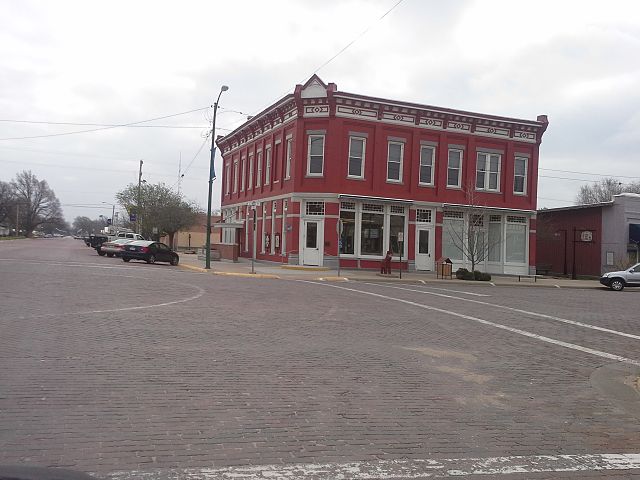BETHANY COLLEGE, Swensson and 2nd Sts., was founded in 1881, largely through the efforts of Dr. Carl A. Swensson, who served as its first president. Classes opened on October 15, 1 88 1, in a building completed during the previous summer. The following year the college was placed under the directorship of the Swedish Lutheran Church, and was incorporated. Its students come, for the most part, from Swedish Lutheran families in the Kansas Conference district of the church. The college, which is coeducational, has an average annual enrollment of about 400. Departments include preparatory, normal, commercial and college training, art, and music.
Dr. Ernst F. Pihlblad, dean of Kansas college presidents, has been president of the college since 1904.
Among the nine buildings on the compact, elm-shaded campus is PRESSER HALL, scene of the annual music festivals since 1931. It was named in honor of Theodore Presser, music publisher of Philadelphia, in recognition of his gift of $75,000 to the institution. The building was designed by Henry C. Eckland & Co. of Kansas City, Missouri, and ground for the three-story brick and concrete structure was broken by the Crown Prince of Sweden on his visit to Lindsborg, March 17, 1927. In November 1928 the first wing, including the auditorium, which has a seating capacity of 2,750, was completed. The studio wing, with studios, classrooms, rehearsal halls, and practice rooms, was completed in 1930.
Benefit concerts contributed materially to the building fund and the structure was completed without indebtedness. Mme. Schumann-Heink, who said, "America has no other Lindsborg, I want to have a hand in this one," gave a benefit recital on May 16, 1926, and on November 2, 1928, Marion Talley, formerly of the Metropolitan Opera, as her contribution, dedicated the auditorium at a recital. The pipe organ is the gift of Francis J. Plyn of Niles, Michigan.
The MAIN BUILDING, a five-story structure of brick and limestone, was completed in 1886. It contains a dining hall, classrooms, chapel, men students' living apartments, science laboratories, and the museum. BETHANY COLLEGE MUSEUM (Editors Note: The museum is now called the Birger Sandzén Memorial Gallery), on the first floor, contains a collection of natural history and ethnology exhibits. It has a valuable numismatic collection containing more than 3,000 specimens of rare gold, silver, copper, and bronze coins.
BETHANY CHURCH is a gray stone structure of classic design with a steeple rising 150 feet and topped with a cross. Here Dr. Swensson held the first Messiah concert. Two wings have been added to the original building which served for a time as a part of Bethany College. Above the altar is a painting by G. N. Malm of Lindsborg, Christ at Bethany, in which the Christ is represented with Lazarus, Martha, and Mary. Left of the altar is The Ascension, and on the right The Resurrection of Lazarus, both by Birger Sandzen.
The church was organized in 1868, and on August 18, 1869, Dr. Olaf Olsson arrived to assume the pastorate, which he occupied until he was called to the presidency of Augustana College.
In 1878, when Dr. Swensson succeeded to the pastorate, the church had 323 communicants. At his first annual meeting it was decided to sell a part of the land granted the church by the Missouri Pacific Railroad and to use half of the proceeds in building an addition to the church, laying the other half aside to be used as a fund for Bethany College.
The SWEDISH PAVILION, home of the Bethany College Art Department, was presented to the college by the Swedish Government through W. W. Thomas, former U. S. Minister to Sweden and Norway. It was part of Sweden's exhibit at the St. Louis World's Fair in 1904 and was reconstructed on the Bethany College campus shortly after the close of the exposition. Built of wood with a red tile roof, the design is based on the old style of Swedish manor house with a main hall and two smaller buildings connected by porticos. AH material used in its construction was brought from Sweden. In the pavilion are paintings by Kansas artists.
BIRGER SANDZEN'S STUDIO, 421 N. 2nd St., a one-story building of frame and stucco, contains a collection of prints, bronzes, wood carvings, and oils. Among the paintings by contemporary artists are The Brown Bottle, and Portrait of a Child by Henry Varnum Poor, former Kansan. Just outside Dr. Sandzen's studio window is The Little Triton, a bronze statue by Carl Milles, which was presented to a group of Milles' Lindsborg friends with the stipulation that it stand in Dr. Sandzen's garden. It was on display at the Texas Centennial Exposition at Dallas in 1936.
Websites about Lindsborg, Kansas:
- Kansas Facts: McPherson County Facts
- City of Lindsborg,Kansas | Facebook
- Lindsborg, Kansas on Wikipedia
- Birger Sandzén Memorial Gallery
- Bethany College
- Svensk Hyllningsfest (Held every two years)
- The Smoky Valley Historical Association | Facebook
- Coronado Heights Park
- McPherson County Old Mill Museum
- Dala Horses and Lindsborg

